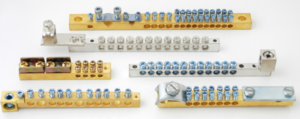
⚡ Brass Earthing Way Terminal
Brass Electrical Parts / Arshit Brass Products
Introduction to Brass Electrical Parts
Brass electrical parts play a vital role in electrical and electronic applications due to their excellent conductivity, durability, and corrosion resistance. These components are widely used in industries such as electrical, electronics, automotive, telecommunication, and construction. Brass electric parts are essential components used in electrical systems due to their excellent conductivity, corrosion resistance, and durability. These parts are typically manufactured from high-grade brass, which offers superior mechanical strength and resistance to wear, making them ideal for both residential and industrial applications.
⚙️ What Are Brass Electrical Parts?
Brass is an alloy made primarily of copper (Cu) and zinc (Zn), with small amounts of other metals like lead or tin to enhance its properties. Brass electrical parts are precision-engineered components designed to connect, secure, or conduct electrical current efficiently.
⚡ Common Types of Brass Electrical Parts
-
Brass Terminals: Used in electrical panels and wiring systems for secure connections.
-
Brass Connectors: Join electrical circuits together, ensuring consistent conductivity.
-
Brass Pins and Sockets: Found in plugs, switches, and sockets to establish electrical contacts.
-
Brass Screws, Bolts, and Nuts: Used to fasten electrical components securely.
-
Brass Cable Glands: Used to secure and protect electrical cables in hazardous or industrial environments.
-
Brass Lugs: Ensure reliable and durable electrical connections in heavy-duty applications.
-
Brass Switch Parts: Components like contacts, levers, and terminals in switches.
-
Brass Fuse Components: Used in fuse carriers and holders for electrical protection.
✅ Advantages of Brass in Electrical Parts
-
High Conductivity: Brass offers excellent electrical conductivity, making it ideal for current-carrying parts.
-
Corrosion Resistance: Resists tarnishing and oxidation, ensuring longevity.
-
Durability: Withstands mechanical stress and offers a longer lifespan.
-
Malleability: Easy to machine and shape into complex parts.
-
Cost-Effectiveness: More affordable than pure copper, offering a balance between price and performance.
️ Applications of Brass Electrical Parts
-
Power Distribution Systems: Terminals, connectors, and cable glands.
-
Automobiles: Electrical connectors and terminals.
-
Telecommunication: Brass contacts in connectors and jacks.
-
Home Appliances: Switch parts, sockets, and fuse holders.
-
Industrial Equipment: Heavy-duty lugs and cable glands.
Brass Electric Parts – Testing and Finishing
-
Testing Process:
-
Dimensional Accuracy: Precision measurement tools ensure the parts meet specified dimensions.
-
Conductivity Testing: Verifies optimal electrical conductivity using resistance meters.
-
Insulation and Dielectric Testing: Ensures no current leakage or short circuits.
-
Plating Adhesion Test: Confirms the coating adheres properly without flaking.
-
Salt Spray Test: Checks corrosion resistance, especially for nickel or chrome-plated parts.
-
-
Finishing Process:
-
Deburring and Polishing: Smoothens edges and enhances surface finish.
-
Plating: Coating with nickel, tin, silver, or gold to improve conductivity and prevent oxidation.
-
Surface Treatment: Passivation or anti-tarnish coating for durability.
-
Inspection: Final visual and functional checks to ensure quality standards.
-
✅ These processes enhance the durability, performance, and appearance of brass electric parts.
